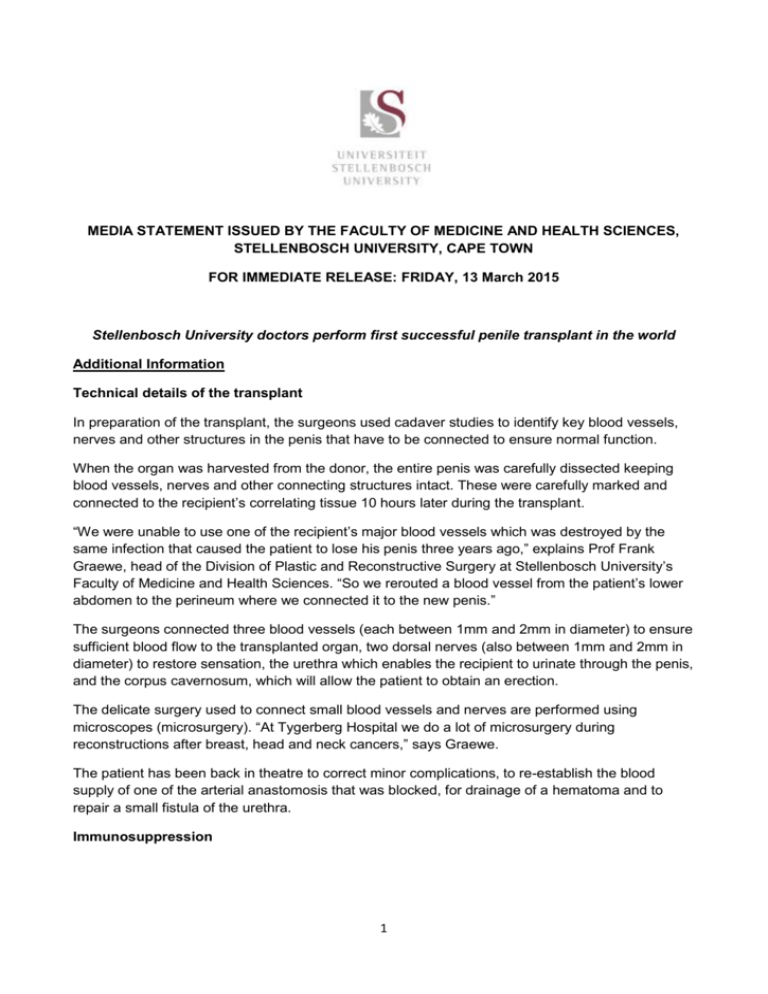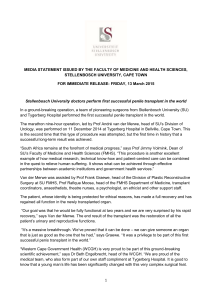Addisional_OrganTransplant_March2015
advertisement

MEDIA STATEMENT ISSUED BY THE FACULTY OF MEDICINE AND HEALTH SCIENCES, STELLENBOSCH UNIVERSITY, CAPE TOWN FOR IMMEDIATE RELEASE: FRIDAY, 13 March 2015 Stellenbosch University doctors perform first successful penile transplant in the world Additional Information Technical details of the transplant In preparation of the transplant, the surgeons used cadaver studies to identify key blood vessels, nerves and other structures in the penis that have to be connected to ensure normal function. When the organ was harvested from the donor, the entire penis was carefully dissected keeping blood vessels, nerves and other connecting structures intact. These were carefully marked and connected to the recipient’s correlating tissue 10 hours later during the transplant. “We were unable to use one of the recipient’s major blood vessels which was destroyed by the same infection that caused the patient to lose his penis three years ago,” explains Prof Frank Graewe, head of the Division of Plastic and Reconstructive Surgery at Stellenbosch University’s Faculty of Medicine and Health Sciences. “So we rerouted a blood vessel from the patient’s lower abdomen to the perineum where we connected it to the new penis.” The surgeons connected three blood vessels (each between 1mm and 2mm in diameter) to ensure sufficient blood flow to the transplanted organ, two dorsal nerves (also between 1mm and 2mm in diameter) to restore sensation, the urethra which enables the recipient to urinate through the penis, and the corpus cavernosum, which will allow the patient to obtain an erection. The delicate surgery used to connect small blood vessels and nerves are performed using microscopes (microsurgery). “At Tygerberg Hospital we do a lot of microsurgery during reconstructions after breast, head and neck cancers,” says Graewe. The patient has been back in theatre to correct minor complications, to re-establish the blood supply of one of the arterial anastomosis that was blocked, for drainage of a hematoma and to repair a small fistula of the urethra. Immunosuppression 1 Immunosuppression is a key component of a successful organ/tissue transplant. “As soon as you put a foreign object into a person, the body’s natural instinct is to reject it. Immunosuppression helps to prevent the body from rejecting the transplanted organ,” says Prof Rafique Moosa, head of the Department of Medicine at Stellenbosch University’s Faculty of Medicine and Health Sciences. All transplants, except where the same person’s own tissue, or that of an identical twin is used, requires immunosuppression. “Because there are no guidelines on this type of transplant, we based our treatment on other composite tissue transplants such as hand and face transplants,” says Moosa. Transplants where several types of cells are involved (muscle, nerve, blood vessels, etc.) require stronger immunosuppression treatment than transplants of organs involving fewer cells, for example, kidneys. The immunosuppression drugs used for the penile transplant, although not usually used as a firstline treatment, are available in state facilities and are generally used for kidney transplant patients. Although the drug doses are progressively lowered, transplant patients have to take immunosuppression medication for the rest of their lives – even if the patient made a full recovery. Ethical considerations The investigators proactively sought to cover all ethical aspects of the study and were granted permission from Stellenbosch University’s Health Research Ethics Committee (HREC) in 2011. They closely consulted with ethicists as well as the HREC throughout the design and conduct of the study. According to Dr Nicola Barsdorf, head of Health Research Ethics at the FMHS, the research team adequately addressed the important ethical issue of therapeutic misconception (the risk that a research participant may not fully understand that this treatment is only experimental). “The patient was repeatedly counselled over an extended period of time on the potential benefits and risks of the procedure. He had a clear understanding of the experimental nature of the transplant and after multiple, comprehensive discussions about the voluntary nature of his participation, provided his informed consent,” explains Barsdorf. The research also met the ethical benchmark of social justice as it would benefit all sectors of society. “The research was conducted in partnership with local public health structures and will be delivered to the people who need it most,” says Barsdorf. “Once the surgery is made broadly available it will be offered in state facilities and be accessible to vulnerable groups that are often unable to afford or access state of the art health care.” Psychological aspects of transplant All patients considered for the study had to undergo extensive psychological evaluation to determine whether they were mentally fit to receive a transplant. Organ transplantation could have a negative psychological effect when patients that can’t associate with the organ. Other penile replacement options 2 Current surgical options for patients include penis reconstruction with free tissue transfer. For this procedure skin tissue (“flap”) is taken from the arm, reconstructed into a penis, and attached to the body. A prosthesis can be implanted in order to allow sexual intercourse, but is expensive (around R100 000) and may develop complications. However, unlike the transplant, with a reconstruction a patient cannot conceive naturally. The first attempted penis transplant in 2006 In 2006, surgeons from Guangzhou General Hospital in China for the first time transplanted a penis from a donor to a 44-year old man who had lost his penis in an accident. However, two weeks after the operation surgeons had to remove the organ. Although it showed no signs of rejection by the body, reports claim that it was removed for psychological reasons. Ends 3





